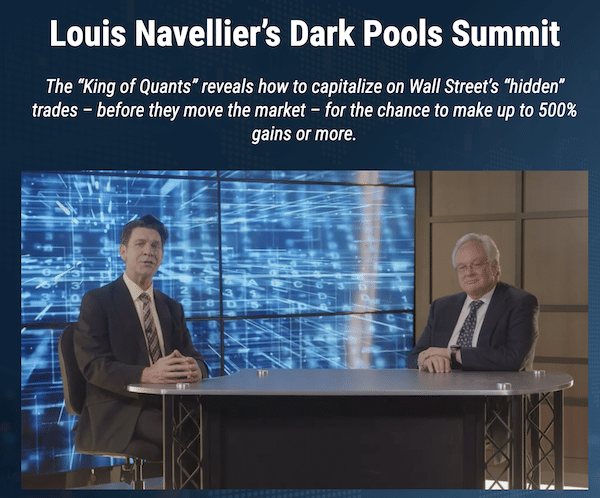Today I’ll be breaking down a new presentation from Louis Navellier about “dark pools.”
Louis says that dark pools, along with his “high-speed computers and complex algorithms,” can help you capitalize on Wall Street’s “hidden” trades.
Trades that, according to Louis, could “make up to 500% gains or more.”

What is a dark pool? And can Louis Navellier really help you profit from them?
These are some of the questions I hope to answer in this post.
We’ll start by looking at the claims Louis makes in the presentation and whether or not they have any merit. Then we’ll take a closer look at how Louis Navellier’s strategy works to help you decide if his Breakthrough Stocks service is worth joining.
The Dark Pools Summit – Make 500% Gains From Wall Street’s “Hidden” Trades?
I’ve heard of dark pools before, but this is the first time I’ve heard Louis Navellier mention them, much less do an entire presentation about how you can capitalize on them. So I was curious and wanted to learn more, which led me down quite the rabbit hole.
Let’s start with what a dark pool actually is.
According to Investopedia, dark pools are “private exchanges for trading securities that are not accessible by the investing public.” And they were created to “facilitate block trading by institutional investors who did not wish to impact the markets with their large orders.”
In other words, dark pools act as a kind of “alternate stock market” for institutional investors who don’t want to move the market when they buy or sell large quantities of shares.
Despite the somewhat shady name, dark pools are legitimate and are used for a legitimate purpose, albeit one that gives Wall Street an unfair advantage on retail investors.
See, when regular investors like you and I buy or sell shares, it’s almost certainly not going to move the market. But institutions are working with millions, sometimes billions, of dollars.
So when they place a large trade, it can move the market and make it harder for them to get the price they originally wanted.
For example, if an institutional investor wants to buy $500 million worth of shares of a company and places an order on the regular stock exchange, the order may not get “filled” in one go.
As a result, the order may need to be split up into smaller orders, and all of this buying activity could bid up the price of the shares in the process. So, by the time the institution completes the order, they could end up paying more.
And the inverse is true when it comes to selling shares.
The institution may get less money than they want when selling large volumes of shares on “regular” markets. So they use dark pools, which allow them to interact with other institutional investors anonymously and fill their orders without impacting the price.
This video I found on Youtube does a better job of explaining it than I could:
At the end of the day, institutional investors are the main beneficiaries of this system. But this subject is relevant to retail investors because once those large institutional buy or sell orders are completed and publicly reported, the stock price can move in the regular market.
And depending on the market cap of the company and the size of the dark pool trades, the share price could potentially explode higher, or nosedive, within a very short time.
This is more common than you might think, too. Believe it or not, it’s estimated that around 40% of all executed trades are completed across dozens of individual dark pools.
So, long story short, that’s the gist of what dark pools are about and why they matter.
And this is what Louis’ pitch centers around. He says that once he figured out what was going on with the dark pools, he started developing a system to capitalize on it.
Once I figured this out, it was a game changer…
So I set about developing a system that could determine the massive buying and selling that takes place in the Dark Pools… before it moves an individual stock.
According to Louis, he has outperformed the market 6-to-1 over several years in a row as a result of his research and likens his strategy to “playing poker and being able to see your opponents’ hand before you place your bets.”
Throughout the presentation, Louis provides numerous examples of stocks he’s recommended as a result of the system he created for determining what might be happening in the dark pools.
Here are a few examples he provides in the presentation:
- Enterra Energy (273% gain)
- Spreadtrum Communications (172% gain)
- Nutrisystem (169% gain)
- Netflix (112% gain)
- Arbor Realty (155% gain)
Of course, not all of Louis’ recommendations have been that profitable, but it goes to show what’s possible. And in the next section, we’ll dig deeper into how his system works to try to figure out how he’s uncovering these types of opportunities.
How Does Louis Navellier’s “Dark Pool Strategy” Work?
It’s unclear if Louis Navellier has access to the dark pools or not. And if so, whether he’s using that information to identify high potential stocks or if it’s more of an educated guess.
I say this because, unless I missed it, he never actually says he’s basing his stock recommendations on what’s taking place in the dark pools.
However, he does run a money management firm called Navellier. One that, according to his profile on the InvestorPlace website, manages over $5 billion for institutional clients.
Navellier is an accomplished Wall Street insider as well. He and his team of more than 50 professional analysts and staff manage over $5 billion in mutual funds and institutional accounts through his fund management company, Navellier & Associates.
Source: investorplace.com/author/louis-navellier
From what I can tell, Navellier & Associates is now simply called “Navellier.” So assuming that’s the case, Louis runs a multi-billion-dollar money management firm.
And if that’s the case, he may well have access to dark pools.
Either way, I can’t say for sure one way or the other. I can only go off what he says and publicly available information. And from what Louis says, it seems like he’s basing his picks on what he thinks is “likely” to happen in the dark pools, not what “is” happening in dark pools.
In a nutshell, Louis says he uses his “high-speed computer systems” and “expert analysis” to interpret which stocks Wall Street is likely to be interested in – before they place their trades in dark pools. And the main factor he looks at relates to a company’s earnings.
I’ve found a way to interpret which stocks Wall Street is eyeing before they place their massive orders in the Dark Pools.
Researching the stock market with my high-speed computer systems and my expert analysis over the past few decades, crunching billions of data points… what I’ve come to discover is that Wall Street puts “earnings” into eight different categories… that is, they look at all the money that comes into – and flows through– a business through eight different metrics, and size companies up that way.
So the main thing he looks at to figure out what stocks Wall Street is most interested in is earnings. And he says he looks at eight earnings categories in particular:
- Positive Earnings Revisions
- Positive Earnings Surprises
- Increased Sales Growth
- Expanding Operating Margins
- Strong Cash Flow
- Earnings Growth
- Positive Earnings Momentum
- High Return on Equity
Louis says he analyzes each of these factors in detail to try to determine when Wall Street is about to take a significant position in the dark pools.
And says he engineered his system to create an “earnings profile” for each public company, out of more than 5,000, and assign it a “quantum score.”
I analyzed all the factors – down to the most stringent details – in an effort to learn exactly WHEN Wall Street is about to take a big position.
Once I figured this out, I engineered my system to create an “earnings profile” for every public company based on these eight factors… and assign it a score which I call a “quantum score.”
The more attractive a company’s “earnings profile,” the higher the “quantum score”… the more likely it will attract the attention of Wall Street.
According to Louis, this “quantum score” helps determine which stocks are most worth getting into and which ones to sell.
What Are Louis Navellier’s “Dark Pool” Stock Picks?
During the presentation, Louis says he’s identified “5 stocks that each registered “quantum scores” above 90″ and says he shares these picks in a special report titled “Five Breakthrough Stocks That Could Soar 1,000% in Total!”
However, to access that report, you need to join his advisory service called Breakthrough Stocks. As a member of this service, you get access to Louis’ latest “dark pool” stock picks and a report called “The Dark Pool Investing Primer” that walks you through his strategy in more detail.
In it, he talks about each of the eight earnings categories mentioned earlier and how these play a role in how he tracks institutional buying.
So, to sum it up… to get Louis’ stock picks that relate to dark pools, you need to join his Breakthrough Stocks service through the InvestorPlace website.
What Is Breakthrough Stocks?
Breakthrough Stocks is an investment advisory service run by Louis Navellier of InvestorPlace. The service focuses on identifying small-cap stocks with considerable upside potential, which Louis says he does with the help of his “Quantum Scoring” research.
A small-cap stock has a market capitalization of between $300 million and $2 billion.
And the good thing about small caps is that it takes a relatively small sum of money from investors to push the stock price up. In my mind, this is also what makes small-caps an interesting combination with Louis’ dark pool strategy.
Because, for example, if you were able to determine that large sums of money from Wall Street could be about to flow into a small stock and get ahead of it, the upside could be huge.
However, the inverse is also true.
A relatively low amount of selling pressure can cause the price of a small-cap stock to fall more rapidly than a larger stock. So it’s also possible you can lose a lot of money in a short time.
This is why it’s essential to consider the risks and do your own due diligence before deciding anything. That way, you have a better idea of what you’re getting yourself into.
How has the service been performing?
According to the InvestorPlace website, Louis Navellier has found “over 150 double- triple-, and even quadruple-digit gains over just the last few years” using the same type of research that he shares with members of Breakthrough Stocks.
However, the site also says that the average gain of Breakthrough Stocks in 2020 was 14.5%.
So each recommendation on average, accounting for the winning and losing recommendations, was 14.5%. This is a long way from triple-digit gains. But in my opinion, that’s still excellent and gives you a more realistic idea of what to expect as a member of the service.
Also, keep in mind that, among other factors, it depends on which recommendations you choose to follow as to how successful you’ll be. As a member, you can pick and choose which stocks you like, which can make a big difference in how well your portfolio does.
What Do You Get If You Join Breakthrough Stocks?
The main thing members of Breakthrough Stocks get access to is the monthly issues of the service that detail Louis’ latest research and insights, as well as his latest recommendations on the small-cap stocks he’s most interested in.
You also get the bonus reports I mentioned earlier if you join through the presentation, access to the model portfolio, updates on the portfolio, and alerts about what he recommends buying and selling at any given time via email.
In a nutshell, you get access to everything you need to learn about Louis’ small-cap recommendations and strategy. From there, you can decide which stocks to take advantage of using your own broker account.
Membership Fee and Refund Policy
According to the InvestorPlace website, the cost of joining Breakthrough Stocks usually is $2,999 per year. But if you join through Louis’ presentation about dark pools, it’s $1,595 for 12 months.
At almost half price, that’s a pretty steep discount. But there are no cash refunds on this offer, so if you decide it’s not for you after joining, it won’t be possible to recover your money.
However, the site does say you can get a second year of the service if it doesn’t give you at least seven chances to double your money over the next 12 months.
If you don’t see seven 100% winners over the next year, just call our friendly U.S.-based customer service team and you’ll receive a second year of Breakthrough Stocks absolutely free.
Who Is Louis Navellier?
Louis Navellier is the man behind the presentation about dark pools and editor of Breakthrough Stocks, along with other services, including Growth Investor, Accelerated Profits, and Power Options.
His most popular service is Growth Investor. This service launched in 1998 and, according to the InvestorPlace website, has “beaten the S&P 500 by a margin of 3-to-1 over the past 17 years.”
He has recommended countless double- and triple-digit stocks over the years, but 3X’ing the S&P 500 is a very respectable average over such a long timeframe.
It’s common for investment gurus to show you the “highlights.” But in my opinion, it’s more important to consider the average return of their recommendations and how long the service has been running. Because this can give you a better idea of how the service has performed.
In this case, Louis has a solid track record. Not only has he got more than four decades of experience as an investor, but his services have a good track record.
Of course, there are no guarantees that his recommendations will make you money, and there are always risks involved. But he seems like one of the more authentic gurus in the space.
Besides his work with InvestorPlace, Louis owns a successful money management firm that manages billions of dollars, authored a best-selling book titled “The Little Book That Makes You Rich,” and often appears on shows like CNBC and Fox Business News.
Bottom Line
The idea of peering behind the curtain to see what’s going on in the “dark pools,” then using that information to “front-run” Wall street, is likely an exciting prospect for everyday investors.
Wall Street may use them for legitimate purposes, but let’s face it… dark pools give them an unfair advantage. And Breakthrough Stocks is, more or less, about leveling the playing field.
As far as I know, Louis Navellier isn’t sharing information with subscribers about the transactions taking place on dark pools. However, he does share his insight into which stocks he thinks are likely to attract institutional investors. And that could prove beneficial to his subscribers.
At the end of the day, it depends on your goals, investing preferences, and circumstances as to whether or not it’s worth joining Breakthrough Stocks.
But it could be worth checking out if you want to learn from Louis and see which “dark pool” stocks he’s tracking. Either way, I hope you found this helpful.





Please note: By submitting a comment using the above comment form, you confirm that you agree with the storage and handling of your data by this site as detailed in our Privacy Policy.